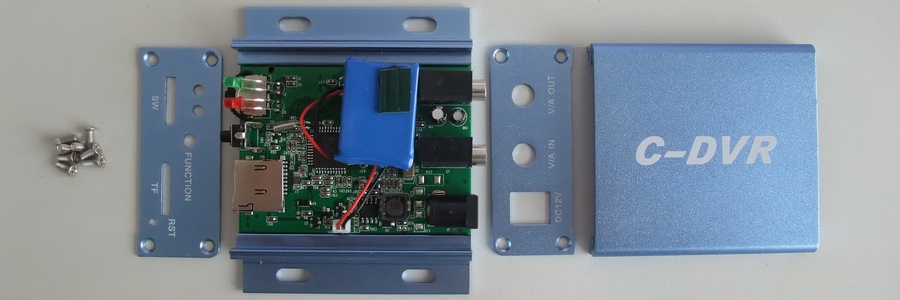C-DVR
The C-DVR is small video recorder that takes composite video as input, digitize the video and store on a MicroSDHC card.
Digitizing can be in 320 * 240 resolution (QVGA) or in 640 * 480 (VGA). Audio is recorded in mono.
However the C-DVR only records 12 frames (images) per second. That is half the video images of PAL SD TV. Also a time stamp is permanently placed in the corner of the video. The product is clearly intended for recording security where the low frame rate is not important, but for film recording it is not useful.
The recorder stores in AVI file format on the memory card. Recording in VGA resolution uses ca. 520 KiB/s.
Using VideoLAN VLC the audio / video format is reported as:
Video Code Motion JPEG Video (MJPG)
Video Format Resolution 640 * 480, 12 FPS
Active Video Resolution 524 * 428 pixels
Planar 4:2:0 YUV full scale
Audio codec PCM S16 LE (araw)
Mono, 8KHz, 16 bits per sample.
A MicroSDHC is used, so max 32 GiB capacity. The format should be FAT32. At the memory card slot, it is indicated "TF" short for Trans-Flash, the defacto name used by Asian companies for SD card, probably used to avoid paying a SD card manufacturing license.
There is both a video-in (V/A IN) and video-out (V/A OUT) connector. The camera should of course be connected to the video-in. A video monitor can be connected to the video-out. The video-out is a not simply a amplification of the the video-in signal, rather it is a low resolution (QVGA) quality output. This happens even if the recording is done in full VGA quality.
The video cables have BNC plugs, but adapters for RCA connectors are included.
Physical size: 70 * 84 * 25 mm. Mass: 110 g

The setup is done with and on-screen menu. To do the setup a video monitor must be connected to the video-out. For the menu navigation use the "wheel" to the left of the MicroSD slot. It is not really a wheel, as it can only be dragged a bit to the left or right and a spring pulls it back to the centre. Drag left or right to move in menu and press wheel for enter. So three buttons made as a pseudo-wheel.
When the device is on it auto-runs and records to the MicroSDHC card. To eject the memory card without causing a file corruption, press the button labelled "Function". This temporary stops the recording for ca. 10 s, LED blinking and memory card can safely be removed.

The enclosure is in aluminium. Standard Phillips screws is used; nice!
On the cicuit board a 1 cell LiPo battery is connected to power a real-time clock when the device is not connected to power. The battery is then auto recharged during normal operation.
Tags: Review, video recorder, CDVR
Page link: <http://foersom.org/review/CDvr.html>
Edited: 2014-01-14